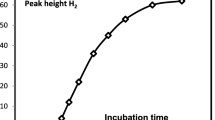Abstract
The identification of bacteria by using conventional microbiological techniques can be very time-consuming and circumstantial. In contrast, the headspace screening of bacterial cultures by analyzing their emitted volatile compounds using mass spectrometry might provide a novel approach in diagnostic microbiology. In the present study different strains of Escherichia coli, Klebsiella, Citrobacter, Pseudomonas aeruginosa, Staphylococcus aureus, and Helicobacter pylori were investigated. The volatile compounds emitted by these bacteria in vitro were analyzed using proton-transfer-reaction mass spectrometry, which allows rapid and sensitive measurement. The detected patterns of volatile compounds produced by the investigated bacteria were compared and substantial differences regarding both quantity and quality were observed. In conclusion, the present study is the first to describe headspace screening of bacterial cultures as a potential diagnostic approach in medical microbiology.

Similar content being viewed by others
Literature Cited
Bonnarme P, Amarita F, Chambellon E, Semon E, Spinnler HE, Yvon M, (2004) Methylthioacetaldehyde, a possible intermediate metabolite for the production of volatile sulphur compounds from L-methionine by Lactococcus lactisFEMS Microbiol Lett 236:85–90
Burchardi H, Schneider H, (2004) Economic aspects of severe sepsis: A review of intensive care unit costs, cost of illness and cost effectiveness of therapy Pharmacoeconomics 22:793–813
Buzzini P, Martini A, Cappelli F, Pagnoni UM, Davoli P, (2003) A study on volatile organic compounds (VOCs) produced by tropical ascomycetous yeastsAntonie van Leeuwenhoek 84:301–311
Carterson AJ, Morici LA, Jackson DW, Frisk A, Lizewski SE, Jupiter R, et al. (2004) The transcriptional regulator AlgR controls cyanide production in Pseudomonas aeruginosaJ Bacteriol 186:6837–6844
Korpi A, Pasanen AL, Pasanen P, (1998) Volatile compounds originating from mixed microbial cultures on building materials under various humidity conditionsAppl Environ Microbiol 64:2914–2919
Kuzma J, Nemecek-Marshall M, Pollock WH, Fall R, (1995) Bacteria produce the volatile hydrocarbon isopreneCurr Microbiol 30:97–103
Lindinger W, Hansel A, Jordan A, (1998) On-line monitoring of volatile organic compounds at pptv levels by means of proton-transfer-reaction mass spectrometry (PTR-MS): Medical applications, food control and environmental researchInt J Mass Spectrom Ion Processes 173:191–241
Probert CS, Jones PR Ratcliffe NM, (2004) A novel method for rapidly diagnosing the causes of diarrhoeaGut 53:58–61
Author information
Authors and Affiliations
Corresponding author
Rights and permissions
About this article
Cite this article
Lechner, M., Fille, M., Hausdorfer, J. et al. Diagnosis of Bacteria In Vitro by Mass Spectrometric Fingerprinting:A Pilot Study. Curr Microbiol 51, 267–269 (2005). https://doi.org/10.1007/s00284-005-0018-x
Received:
Accepted:
Published:
Issue Date:
DOI: https://doi.org/10.1007/s00284-005-0018-x




